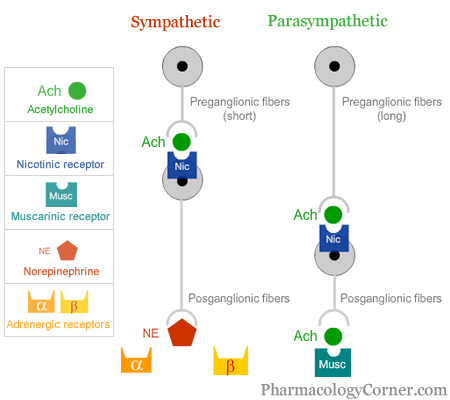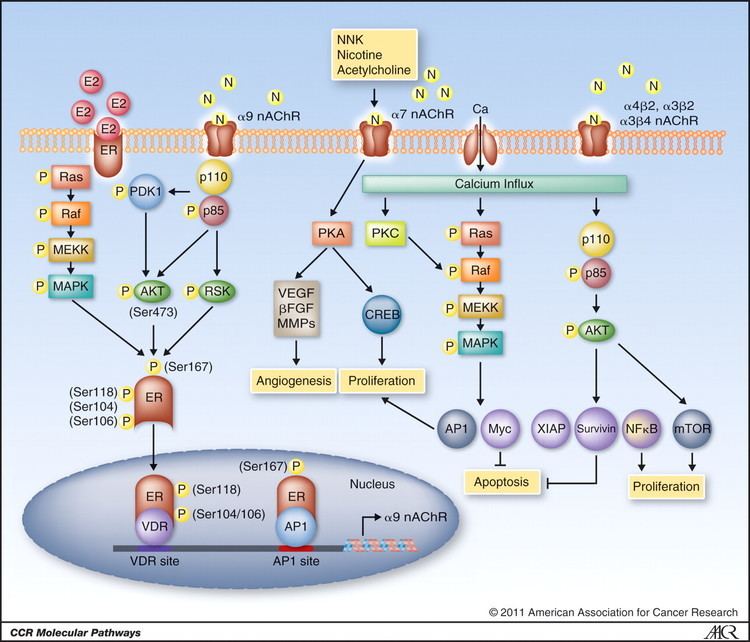External IDs GeneCards: [1] Human Mouse n/a n/a | Species Human Entrez n/a | |
 | ||
Aliases cholinergic receptorAChRACh receptorCholinoceptor | ||
Nicotinic acetylcholine receptors and your brain
An acetylcholine receptor (abbreviated AChR) is an integral membrane protein that responds to the binding of Acetylcholine, a neurotransmitter.
Contents
- Nicotinic acetylcholine receptors and your brain
- Introduction to nicotinic acetylcholine receptors part 1
- Classification
- Receptor types
- nAChR
- mAChR
- Role in health and disease
- References

Introduction to nicotinic acetylcholine receptors part 1
Classification
Like other transmembrane receptors, acetylcholine receptors are classified according to their "pharmacology," or according to their relative affinities and sensitivities to different molecules. Although all acetylcholine receptors, by definition, respond to acetylcholine, they respond to other molecules as well.

Nicotinic and muscarinic are two main kinds of "cholinergic" receptors.
Receptor types
Molecular biology has shown that the nicotinic and muscarinic receptors belong to distinct protein superfamilies.

Nicotinic receptors are of two types: Nm and Nn. Nm is located in the neuromuscular junction which causes the contraction of skeletal muscles by way of end-plate potential (EPPs). Nn causes depolarization in autonomic ganglia resulting in post ganglionic impulse. Nicotinic receptors cause the release of catecholamine from the adrenal medulla, and also site specific excitation or inhibition in brain. Both Nm and Nn are Na+ and Ca++ channel linked but Nn is also linked with an extra K+ channel.
nAChR

The nAChRs are ligand-gated ion channels, and, like other members of the "cys-loop" ligand-gated ion channel superfamily, are composed of five protein subunits symmetrically arranged like staves around a barrel. The subunit composition is highly variable across different tissues. Each subunit contains four regions which span the membrane and consist of approximately 20 amino acids. Region II which sits closest to the pore lumen, forms the pore lining.

Binding of acetylcholine to the N termini of each of the two alpha subunits results in the 15° rotation of all M2 helices. The cytoplasm side of the nAChR receptor has rings of high negative charge that determine the specific cation specificity of the receptor and remove the hydration shell often formed by ions in aqueous solution. In the intermediate region of the receptor, within the pore lumen, valine and leucine residues (Val 255 and Leu 251) define a hydrophobic region through which the dehydrated ion must pass.
The nAChR is found at the edges of junctional folds at the neuromuscular junction on the postsynaptic side; it is activated by acetylcholine release across the synapse. The diffusion of Na+ and K+ across the receptor causes depolarization, the end-plate potential, that opens voltage-gated sodium channels, which allows for firing of the action potential and potentially muscular contraction.
mAChR
In contrast, the mAChRs are not ion channels, but belong instead to the superfamily of G-protein-coupled receptors that activate other ionic channels via a second messenger cascade. The Muscarine cholinergic receptor activates a G-protein when bound to extracellular ACh. The alpha subunit of the G-protein deactivates adenylate cyclase while the beta-gamma subunit activates the K-channels and therefore hyperpolarize the cell. This causes a decrease in cardiac activity.
Role in health and disease
Nicotinic acetylcholine receptors can be blocked by curare, hexamethonium and toxins present in the venoms of snakes and shellfishes, like α-bungarotoxin. Drugs such as the neuromuscular blocking agents bind reversibly to the nicotinic receptors in the neuromuscular junction and are used routinely in anaesthesia.
Nicotinic receptors are the primary mediator of the effects of nicotine. In myasthenia gravis, the receptor at the neuromuscular junction is targeted by antibodies, leading to muscle weakness. Muscarinic acetylcholine receptors can be blocked by the drugs atropine and scopolamine.
Congenital myasthenic syndrome (CMS) is an inherited neuromuscular disorder caused by defects of several types at the neuromuscular junction. Postsynaptic defects are the most frequent cause of CMS and often result in abnormalities in nicotinic acetylcholine receptors. The majority of mutations causing CMS are found in the AChR subunits genes.
Out of all mutations associated with CMS, more than half are mutations in one of the four genes encoding the adult acetylcholine receptor subunits. Mutations of the AChR often result in endplate deficiency. Most of the mutations of the AChR are mutations of the CHRNE gene. The CHRNE gene codes for the epsilon subunit of the AChR. Most mutations are autosomal recessive loss-of-function mutations and as a result there is endplate AChR deficiency. CHRNE is associated with changing the kinetic properties of the AChR. One type of mutation of the epsilon subunit of the AChR introduces an Arg into the binding site at the α/ε subunit interface of the receptor. The addition of a cationic Arg into the anionic environment of the AChR binding site greatly reduces the kinetic properties of the receptor. The result of the newly introduced ARG is a 30-fold reduction of agonist affinity, 75-fold reduction of gating efficiency, and an extremely weakened channel opening probability. This type of mutation results in an extremely fatal form of CMS.
